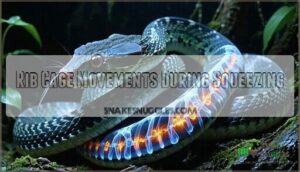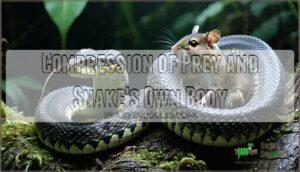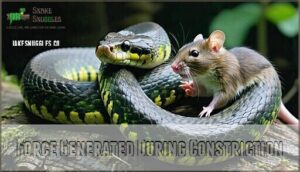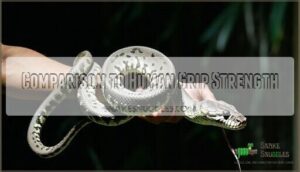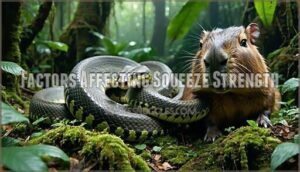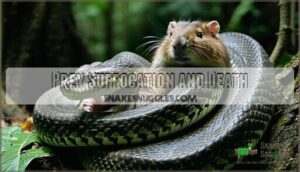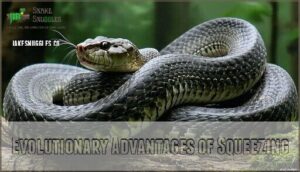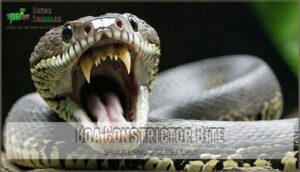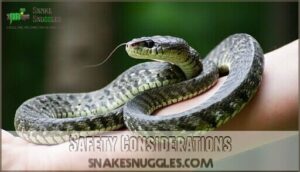This site is supported by our readers. We may earn a commission, at no cost to you, if you purchase through links.

These serpents don’t crush bones like a vice—they’re smarter than that. Instead, they cut off your blood flow and breathing through precise pressure that reaches 300 pounds per square inch.
It’s like having a living tourniquet wrapped around you, tightening with each heartbeat until circulation stops. The snake monitors your essential signs through sensitive scales, adjusting pressure accordingly.
Death comes within 6-10 minutes through circulatory arrest, not suffocation. Understanding how size, muscle mass, and prey selection influence this deadly embrace reveals fascinating survival strategies, and highlights the importance of efficient killing.
Table Of Contents
- Key Takeaways
- Boa Constrictor Squeeze Anatomy
- Pressure Exerted by Boa Constrictors
- Factors Affecting Squeeze Strength
- Prey Suffocation and Death
- Evolutionary Advantages of Squeezing
- Boa Constrictor Bite
- Safety Considerations
- Frequently Asked Questions (FAQs)
- How strong is a boa constrictor squeeze?
- Why does a boa constrictor squeeze its prey?
- What to do if a boa is constricting you?
- What is it called when a snake squeezes you?
- Why do boa constrictors squeeze their prey?
- What to do if a snake squeezes you?
- What is it called when a snake squeezes?
- What is a boa constrictor choke hold?
- How do boa constrictors suffocate?
- How much pressure does a boa constrictor squeeze?
- Conclusion
Key Takeaways
- You’re witnessing circulatory collapse, not bone crushing—boa constrictors apply 14-42 PSI to cut off blood flow and cause cardiovascular shutdown within 6-10 minutes, not suffocation.
- You’ll find these snakes monitor their prey’s heartbeat through sensitive scales, adjusting pressure with each pulse until the heart stops beating, then immediately reducing force to conserve energy.
- You can’t match their sustained crushing power—while your strongest handshake reaches 7 PSI, boa constrictors maintain 6 times that force without fatigue through specialized overlapping muscle rings.
- You’ll stay safer by supporting the snake’s body weight and unwrapping from tail to head if constricted, never allowing wraps around your neck, and watching for stress signals like defensive posturing.
Boa Constrictor Squeeze Anatomy
When you examine a boa constrictor’s anatomy, you’ll discover that specialized skeletal muscles arranged in overlapping rings create the powerful constriction mechanism that can generate up to 42 pounds of pressure per square inch.
Nature’s living vice grip: overlapping muscle rings that crush with surgical precision, delivering 42 PSI of calculated death.
The snake’s flexible rib cage expands and contracts in coordinated movements, allowing it to compress both its prey and its own body during the squeezing process without causing self-injury, which is a result of its unique constriction mechanism.
Rib Cage Movements During Squeezing
A boa constrictor’s incredible squeezing power relies on sophisticated rib cage mobility that you’d never expect.
When constricting prey, the snake makes precise breathing adjustments by shifting rib motions toward its head or tail.
X-ray videos with marker placement have revealed these rib kinematics across different lung sections.
Here’s how rib cage compression works during hunting:
- Ribs compress around prey while maintaining airflow elsewhere
- Rib movement shifts to uncompressed body sections automatically
- Breathing continues despite intense constriction pressure
- Boa constrictor survives its own deadly embrace
Compression of Prey and Snake’s Own Body
While the boa constrictor wraps around prey, its rib cage creates selective compression zones that protect essential organs.
You’ll notice the snake’s muscular arrangement allows Self-Squeeze Tolerance – it won’t crush itself during constriction.
Breathing Adaptations let certain ribs expand while others compress, maintaining oxygen flow despite the deadly squeeze.
This Blood Flow Impact on prey proves fatal, yet the snake’s Organ Protection mechanisms keep it safe.
The predator’s body becomes both weapon and shield during this intimate dance of death.
Pressure Exerted by Boa Constrictors
When you witness a boa constrictor in action, you’re seeing a biological machine that generates up to 42 pounds of pressure per square inch, which is roughly six times stronger than your firmest handshake.
This crushing force, distributed evenly across the snake’s 7-10 foot body, can exert a total constricting power of nearly 920 pounds against its prey.
Force Generated During Constriction
When you witness a boa constrictor’s deadly embrace, you’re seeing approximately 14-29 PSI of constriction force in action.
This powerful grip creates enough pressure exerted to restrict blood flow within minutes.
The snake’s specialized muscle arrangement generates crushing force through overlapping rings, with some specimens reaching 42 PSI.
While bone breaking isn’t the primary goal, these squeeze mechanics easily overpower prey through cardiovascular collapse, making squeeze duration brief but devastatingly effective.
Boa constrictors also display varied <strong>foraging and dietary</strong> habits.
Comparison to Human Grip Strength
Imagine your strongest handshake—now multiply that force by six. That’s the grip strength PSI a boa constrictor delivers during constriction force.
While your human grip strength peaks around 100-200 pounds per square inch, these serpents generate 6-12 PSI with devastating squeeze mechanics.
The handshake comparison reveals our human vulnerability—we can’t sustain pressure like a boa constrictor can. Their relative muscle power and squeeze endurance operate through specialized biomechanics that maintain constant compression without fatigue.
As ambush predators, they rely on stealth to capture their prey. You’d need superhuman strength to match their sustained crushing ability, making their predatory advantage absolutely overwhelming.
Factors Affecting Squeeze Strength
You can’t assume every boa constrictor squeezes with the same force, because several key factors determine how powerfully these snakes can crush their prey.
A larger snake with more muscle mass will generate substantially stronger pressure than a smaller one, while the size and defensive capabilities of the prey also influence how much squeezing force the boa needs to apply for a successful kill, which involves the snake’s ability to apply the right amount of squeezing force.
The size of the prey is a crucial factor in determining the boa constrictor’s killing strategy.
Snake Size and Muscle Mass
Three factors determine your boa constrictor’s crushing power: muscle mass, body length, and muscle composition.
Larger snakes don’t automatically squeeze harder—it’s about muscle density and size correlation.
A ten-foot boa with robust muscles generates substantially more strength variation than a smaller snake with similar proportions.
This evolutionary advantage allows prey overpowering across different habitats.
Growth rate and prey size adaptability influence muscle development, balancing crushing force with energetic costs for ideal hunting efficiency.
Prey Size and Species
While muscle mass sets the foundation, you’ll find that prey size and species create the real challenge.
Larger animals demand more pressure—a rabbit requires different capture strategies than a bird. Species vulnerability varies dramatically; mammals with thick fur test the snake’s grip differently than smooth-skinned amphibians.
Your boa’s dietary adaptations include prey size adaptability, adjusting constriction force based on resistance. Prey defenses like claws or thick hides force strategic prey capture modifications.
Temperature affects both predator performance and endothermic prey struggle intensity, influencing prey consumption success rates substantially.
Prey Suffocation and Death
When you witness a boa constrictor’s deadly embrace, you’re watching a precisely engineered killing machine that doesn’t crush bones but instead cuts off blood flow to essential organs, causing cardiovascular collapse within minutes.
Nature’s ultimate predator doesn’t break bones—it methodically shuts down life itself through calculated cardiovascular collapse.
You’ll notice the snake monitors its victim’s heartbeat throughout the process, tightening its grip with each detected pulse until the heart finally stops beating, which is a result of the snake’s precisely engineered mechanism and its ability to cause deadly consequences.
Mechanism of Death by Asphyxiation
Boa constrictors don’t simply squeeze prey to death—they orchestrate a calculated shutdown of essential systems.
When you witness this process, cardiovascular collapse occurs first, not suffocation.
Here’s how asphyxiation unfolds:
- Blood flow restriction cuts oxygen to the brain
- Organ damage begins within seconds of constriction
- Respiratory failure follows circulatory collapse
- Essential organs shut down systematically
- Death timeline typically spans mere minutes
Monitoring Prey’s Heartbeat
Your boa constrictor doesn’t just squeeze blindly—it’s listening to your heartbeat.
Through sophisticated sensory mechanisms, these snakes detect cardiac signals during constriction, adjusting squeeze timing with remarkable precision.
Heartbeat monitoring serves critical evolutionary significance, allowing energy-efficient kills.
Snakes also use ground vibration detection to sense their surroundings.
Once your heartbeat stops, the boa constrictor reduces pressure, conserving strength for swallowing.
This heartbeat detection system transforms random crushing into calculated predation, proving these serpents are methodical hunters, not mindless crushers.
Evolutionary Advantages of Squeezing
You’ll discover that squeezing isn’t just about brute force—it’s an energy-efficient hunting strategy that evolved to let boa constrictors tackle prey much larger than their head diameter.
This constriction method allows them to expand their food sources dramatically while conserving precious energy through precise cardiovascular disruption rather than prolonged struggling, which is a key aspect of their hunting strategy.
Ability to Subdue Large Prey
You’re witnessing nature’s evolutionary advantage in action when a boa constrictor tackles prey three times its own weight.
This hunting strategy transforms what seems impossible into routine predatory success.
Their constriction efficiency allows them to overpower deer, monkeys, and even small caimans through calculated pressure distribution.
Large prey becomes accessible food sources, expanding their dietary range substantially.
This adaptation gives boa constrictors access to calorie-rich meals that smaller predators can’t touch, ensuring prey capture success across diverse ecosystems.
Conserving Energy During Feeding
When you’re dealing with a creature that can’t afford to waste calories, heartbeat monitoring becomes a game-changer.
Boa constrictors listen for their prey’s pulse, stopping the squeeze the moment it flatlines.
This efficient kills strategy slashes energy expenditure and reduced kill time, minimizing metabolic cost.
Smart breathing adjustments during constriction further optimize their efficient predatory strategies, proving energy conservation drives survival.
Boa Constrictor Bite
When you think about boa constrictors, you’re probably picturing their famous squeeze, but their bite plays an equally important role in capturing prey.
You’ll discover that these non-venomous snakes use their sharp, backward-curved teeth to grab and hold victims securely before wrapping their powerful coils around them for the fatal constriction.
Role of Biting in Prey Capture
Beyond their legendary squeezing ability, you’ll find that biting serves as the opening move in every boa’s hunting playbook.
Their bite force, while lacking venom, delivers enough power to penetrate skin and establish control, using impressive jaw strength to clamp down on unsuspecting prey.
Key elements of their predatory strategies include:
- Precise targeting of vulnerable body parts for maximum prey immobilization
- Sensory feedback through specialized jaw receptors that guide biting strategies during prey capture, which relies on lightning-fast latching speed.
Venom and Constriction
Unlike venomous serpents, boa constrictors rely entirely on their deadly grip for prey capture. This venom absence forces them toward alternative strategies that pack serious punch.
You’ll find their constriction advantages far outweigh any toxin vulnerability – they’ve mastered predatory strategies that work across diverse prey types without evolutionary tradeoffs that limit diet flexibility.
Their muscular approach proves devastatingly effective, crushing prey within minutes through sheer mechanical force rather than chemical warfare. Understanding snake body language can help prevent bites.
| Hunting Method | Energy Cost | Success Rate |
|---|---|---|
| Venom injection | Low initial | Variable |
| Pure constriction | Moderate | Consistently high |
| Combined approach | High | Species-dependent |
Safety Considerations
When you encounter a boa constrictor in the wild or handle one as a pet, you’ll need proper techniques to avoid the powerful squeeze that can exert up to 42 pounds per square inch of pressure.
You should never allow a boa to wrap around your neck, use calm movements to prevent stress responses.
Lift from the tail end if the snake begins constricting around your body, and remember to always prioritize calm movements to ensure safety.
Avoiding Boa Constrictor Bites
Several bite prevention strategies can keep you safe around boa constrictors. Most incidents occur when handlers ignore warning signs or use improper techniques.
Understanding snake behavior and implementing safety measures dramatically reduces risk. Using proper handling tools can further minimize the risk of bites.
- Recognize warning cues: Watch for defensive posturing, hissing, or rapid tongue flicking before approaching
- Maintain safe enclosures: Secure habitats prevent unexpected encounters and reduce stress-induced aggression
- Practice bite avoidance: Move slowly, avoid sudden movements, and never handle during feeding time
Proper Handling Techniques
When handling a boa constrictor, you’ll need proper handling equipment like snake hooks and thick gloves for protection.
Support the snake’s body weight evenly while avoiding constriction around your limbs—never let it wrap around your neck or arms.
Practice safe lifting techniques by grasping behind the head and mid-body.
Watch for recognizing stress signals like defensive posturing or rapid breathing.
Master emergency unwrapping by gently unwinding from the tail upward.
These safety measures guarantee successful, secure interactions with these powerful constrictors.
To maintain a calm demeanor, use slow, deliberate movements during handling.
Frequently Asked Questions (FAQs)
How strong is a boa constrictor squeeze?
Your powerful serpentine friend delivers a surprisingly gentle yet firm embrace, exerting approximately 6-12 pounds per square inch.
That’s roughly six times stronger than your handshake, easily cutting off blood flow within seconds.
Why does a boa constrictor squeeze its prey?
You’ll discover that boa constrictors squeeze prey to cut off blood circulation and oxygen supply, causing cardiovascular collapse within minutes.
This efficient hunting strategy guarantees quick kills while conserving the snake’s energy for digestion.
What to do if a boa is constricting you?
Stay calm and gently lift the snake from its tail end, slowly unwrapping it from your body.
Don’t pull forcefully or panic, support its weight while carefully removing each coil, moving deliberately and smoothly.
What is it called when a snake squeezes you?
When a snake squeezes you, it’s called constriction.
You’ll experience this powerful grip as the snake wraps around your body, applying pressure that restricts blood flow and breathing until you’re completely immobilized.
Why do boa constrictors squeeze their prey?
When push comes to shove, you’ll find that boa constrictors squeeze their prey to cut off blood circulation and oxygen supply, causing cardiovascular collapse within minutes.
It’s their efficient hunting strategy for subduing larger animals, which is made possible by their ability to squeeze their prey.
What to do if a snake squeezes you?
Remain calm and avoid sudden movements.
Gently unwrap the snake starting from its tail, working toward its head.
Don’t pull or yank.
Support the snake’s body weight while slowly loosening its grip around you, and remember to remain calm.
What is it called when a snake squeezes?
When you encounter a snake wrapping around prey or objects, it’s called constriction.
This powerful squeezing technique restricts blood flow and breathing, allowing the snake to subdue victims efficiently through muscular pressure.
What is a boa constrictor choke hold?
When you’re face-to-face with a boa’s grip, you’re experiencing nature’s perfect chokehold.
The snake wraps around prey, squeezes tight, and cuts off blood flow—not air—until the victim’s heart stops beating.
How do boa constrictors suffocate?
You’ll witness a fascinating process where boas wrap around prey, cutting off blood circulation rather than blocking airways.
Their muscular coils compress the cardiovascular system, causing swift cardiovascular collapse within minutes through precise pressure.
How much pressure does a boa constrictor squeeze?
Steel-like coils tighten around you as boa constrictors exert 14-29 pounds per square inch of crushing pressure.
That’s like a firm handshake spread across your entire body, cutting off blood flow within seconds.
Conclusion
Nature’s living rope demonstrates precision engineering through the boa constrictor squeeze, where calculated pressure replaces brute force.
You’ve discovered how these serpents employ sophisticated circulatory disruption rather than bone-crushing violence, monitoring prey through sensitive scales while applying 300 PSI strategically.
Understanding this deadly embrace reveals evolutionary brilliance—energy conservation meets efficient killing.
Whether you’re fascinated by predator mechanics or concerned about safety, respecting these powerful constrictors guarantees both scientific appreciation and personal protection in encounters with nature’s most methodical hunters.
- https://scitechdaily.com/how-boas-save-themselves-from-suffocating-when-squeezing-their-prey-to-death/
- https://journals.biologists.com/jeb/article/225/6/jeb243119/274764/Modular-lung-ventilation-in-Boa-constrictor
- https://www.researchgate.net/publication/350046797_Linking_Tooth_Shape_to_Strike_Mechanics_in_the_Boa_constrictor
- https://www.science.gov/topicpages/c/constrictors+boa+constrictor.html
- https://citeseerx.ist.psu.edu/document?repid=rep1&type=pdf&doi=4aff8889ec08ceb08aca63b2dd2c15a6deccd546

